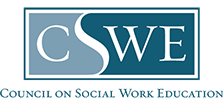Permissions Request
CSWE holds copyright to all publications it produces, unless otherwise stated. If you are interested in reprinting or distributing copyrighted CSWE material, including material from CSWE Press books or from the Educational Policy and Accreditation Standards, please complete the form below and e-mail it to Kristine Luecker.
Permissions Request Form
If the material will be used for a class, include the class title, number of sections, and expected number of students. If material will be reprinted in a commercial publication, include the title, author, print run, and expected publication date.
If you would like permission to reprint material from the Journal of Social Work Education, please contact the journal's publisher, Routledge/Taylor & Francis.
You may also fax your request to +1.703.683.8493, ATTN: Publications Permissions.
Copyright Definitions and Guidelines
The following general guidelines are taken from the circular Copyright Basics, produced by the U.S. Copyright Office of the Library of Congress. The full circular can be found at www.copyright.gov/circs/circ01.pdf.
What is Copyright?
Copyright is a form of protection provided by the laws of the United States (Title 17, U.S. Code) to the authors of “original works of scholarship,” including literary, dramatic, musical, artistic, and certain other intellectual works. This protection is available to both published and unpublished works. (Copyright Basics, p.1)
Copyright is secured automatically when a work is created; no publication, registration, or use of a copyright notice is required. Copyright registration is a legal formality that serves to make public the details of a particular copyright.
Holders of copyright for written works have the exclusive right to
- reproduce copies of a work,
- prepare derivative works based on a work,
- distribute copies to the public, and
- transfer copyright to someone else.
Who Can Claim Copyright?
Copyright protection subsists from the time the work is created in fixed form. The copyright in the work of authorship immediately becomes the property of the author. Only the author or those deriving their rights through the author can claim copyright.
In the case of “works made for hire,” the employer and not the employee is considered the author. (Copyright Basics, p. 2)
A work made for hire is defined as (1) a work prepared by an employee within the scope of his or her employment; or, (2) if the parties have a written contract stating that the work is made for hire, a work specially ordered or commissioned for use, such as a contribution to a collective work, a translation, an instructional text, or a test.
Authors of joint works are co-owners of copyright.
Copyright in each piece of a collective work is held by the original author unless transferred and is distinct from the copyright in the collective work as a whole. For example, each author of each article in a scholarly journal retains copyright until it is transferred in writing to the publisher of the journal. However, there is a separate copyright owned by the publisher for the entire journal as a collected work.
Simple ownership of a book, manuscript, or other work does not give the possessor copyright.
What Is Not Protected by Copyright?
Some categories of material are not eligible for federal copyright coverage:
- works not fixed in tangible form, such as improvisational speeches;
- titles, names, slogans, listings of ingredients or contents;
- ideas, methods, or systems as distinct from description or explanation;
- works consisting entirely of familiar information, such as standard calendars; and
- works by the U.S. government.
Length of Copyright Protection
For works created on or after January 1, 1978, the term of copyright protection is
- the author’s life plus 70 years;
- for joint works, 70 years after the death of the last surviving author; and
- for works made for hire, 95 years from publication or 120 years from creation, whichever is shorter.
For works created before January 1, 1978, the term is 95 years past the date of copyright notice or registration.
Transfer of Copyright
Any or all of the copyright owner’s exclusive rights or any subdivision of those rights may be transferred, but the transfer of exclusive rights is not valid unless that transfer is in writing and signed by the owner of the rights conveyed or such owner’s duly authorized agent. (Copyright Basics, p. 6)
International Copyright Protection
There is no such thing as an “international copyright” that will automatically protect an author’s writings throughout the entire world. Protection against unauthorized use in a particular country depends, basically, on the national laws of that country. However, most countries do offer protection to foreign works under certain conditions, and these conditions have been greatly simplified by international copyright treaties and conventions. (Copyright Basics, p. 6)
The Fair Use Limitation
One of the more important copyright limitations is the doctrine of “fair use.” This doctrine has developed through a substantial number of court decisions and has been codified in section 107 of the copyright law.
Section 107 contains a list of the various purposes for which a particular work may be reproduced without explicit permission, such as criticism, comment, news reporting, teaching, scholarship, and research. Section 107 also sets out four factors to be considered in determining whether a particular use is fair:
- the purpose and character of the use, including whether such use is of commercial nature or is for nonprofit educational purposes;
- the nature of the copyrighted work;
- the amount and substantiality of the portion used in relation to the copyrighted work as a whole; and
- the effect of the use on the potential market for, or value of, the copyrighted work.
The distinction between fair use and infringement may be unclear and is not easily defined. There is no specific number of words, lines, or notes that may safely be taken without permission. Acknowledging the source of the copyrighted material does not substitute for obtaining permission.
When in doubt, the safest course is to request permission for use from the copyright holder.
